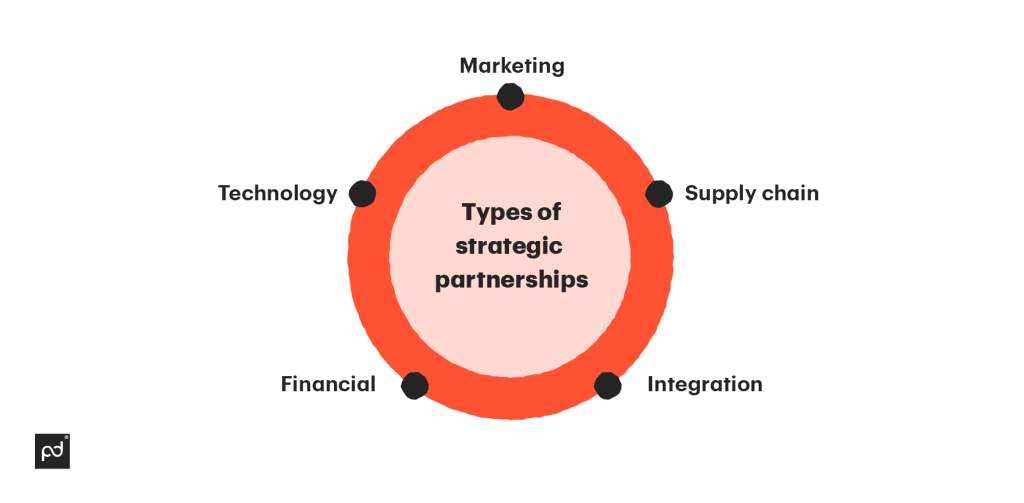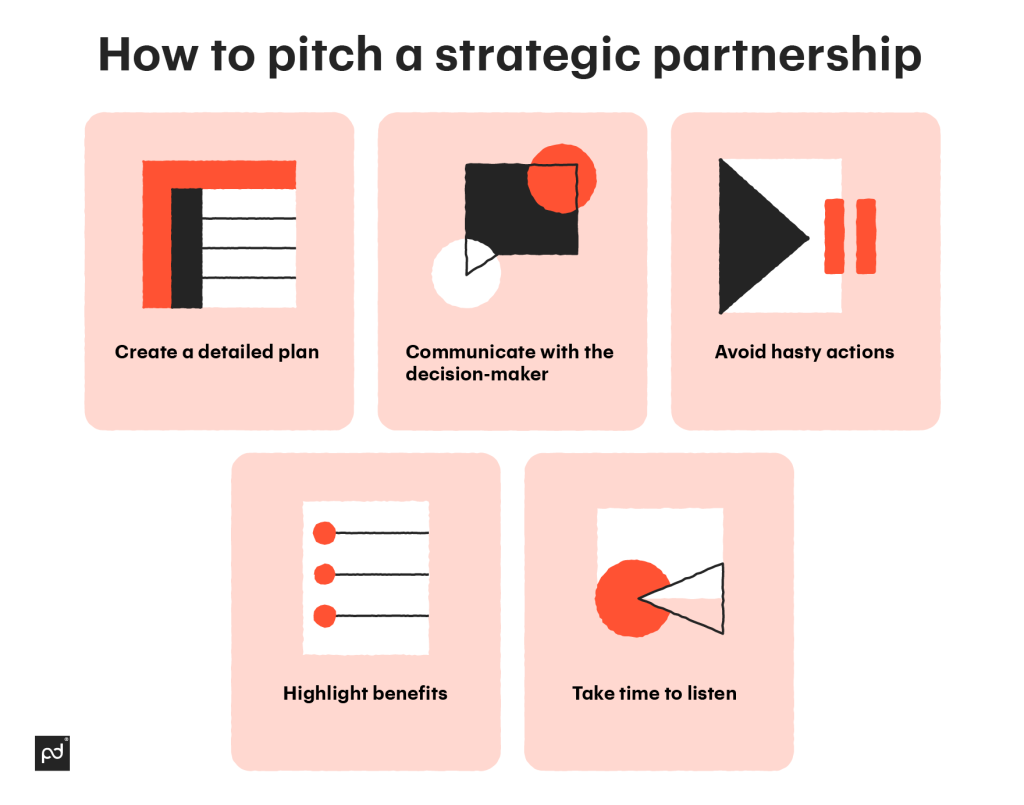A strategic partnership agreement comes about when two businesses intertwine their efforts in a certain area, such as marketing, supply chain, integration, technology, finance, or a combination of these.
A strategic partnership is of value for both parties, and can even be a “match made in heaven” if the two sides involved are matched well.
Initiatives such as this might exist between a digital marketing agency and a graphic designer, a web designer and a database management firm, or an Internet Service Provider (ISP) and an email provider, for example.
Whether you’re a startup or a growth company, there are many reasons to consider entering into a strategic partnership agreement.
At the very least, a strategic partnership will add value to your product or service by expanding what you have to offer your customers.
We’re going to take a look at five common types of strategic partnerships, as well as what goes into a typical strategic partnership agreement, but first:
What is the main purpose of a strategic partnership agreement?
Let’s consider why you would want to enter into a strategic partnership agreement in the first place.
A strategic partnership is a mutually beneficial arrangement between two separate companies that do not directly compete with one another.
Companies have long been engaging in strategic partnerships to enhance their offers and offset costs.
The general idea is that two are better than one, and by combining resources, partner companies can each gain added advantages throughout the period of time the alliance is active.

Partnership Agreement Template
Used 7917 times
This distribution agreement template is designed to help UK distributors accelerate their document signing process. Download your free copy today.
Use this templateForming a strategic partnership should be a straightforward win-win for both parties.
A strategic partnership agreement is necessary for businesses wishing to work together.
Busy sales leaders don’t always have the time or legal resources to get a bullet-proof legal document ready in a timely manner.
Allowing PandaDoc to do most of the hard work means you can close partnership deals in no time.
For example:
A good example of a business partnership agreement between brands that you may have heard of includes Starbucks’ in-store coffee shops at Barnes & Nobles bookstores.
HP and Disney’s ultra hi-tech Mission: SPACE attraction is another typical example of a strategic partnership agreement.
But that’s just the tip of the iceberg.
Virtually everyone who’s anyone is partnering in some way, even if it’s not obvious to the public.
In an ideal partnership, you benefit not only from adding value for your customers but from lowering costs as well.
That’s why every strategic partnership is ultimately an act of leveraging costs versus return.
Say, for instance, you’re a New York based manufacturer about to launch a new product.
A partnership with a company in another state or country might help you save costs on export controls and other applicable laws, as well as giving you a new market.
Before diving into a partnership, size up the other party and carefully evaluate the benefits and risks of entering into the agreement.
If you can satisfy your profit goals and customer expectations through the partnership, then it’s the right call for your business.
What are the five types of strategic partnerships?
Now let’s look at each of the five common types of strategic partnership agreements:

1. Strategic marketing partnerships
This type of strategic partnership agreement is most beneficial to small businesses in the private sector with a limited selection of products and services to offer customers.
Maybe you have a company that provides one service, say logo design.
You might do well to partner with a web developer that will always refer you when graphics are necessary, and vice versa.
Referral agreements are probably the most basic and informal type of strategic alliance agreement, but strategic marketing partnerships can be considerably more complex.
Case in point:
The pharmaceutical company, Abbott India’s an agreement to market Zydus Cadila drugs across India.
An agreement like this one allows each company to focus on what it does best.
In this case, Zydus Cadila gets to focus on manufacturing medications while Abbott India hones in on marketing the drugs.
Marketing partnerships are extremely common in the automotive industry, too, such as the Toyota IQ also being marketed as the Aston Martin Cygnet.
The idea is that one company makes a product and another adds its own marketing spin to it in order to tap into a new market.
The same logic can be applied to a variety of different products, so it’s something worth considering in many situations.
If you’re interested in forming a strategic marketing partnership, you want to look for either a referrer that you share a customer base with or a company operating in a related field that can market your goods or services to a new audience.
2. Strategic supply chain partnerships
Another popular (and extremely valuable) type of alliance is the strategic supply chain partnership.
One of the most obvious places where you can see strategic supply chain partnerships in action is the film industry.
If you’ve ever noticed that the opening credits of most movies list various oddly named companies before the film starts, it’s because movies are typically made in a supply chain method.
A comparatively small production house will handle the filming and post-production, and a larger studio will handle financing, marketing, and distributing the film.
Think of J.J. Abrams’ Bad Robot and Paramount Pictures, which maintain such a partnership agreement.
Other examples of supply chain partnerships come to us from the technology sector. Intel makes processors for many computer manufacturers.
Toyota makes engines for Lotus sports cars.
Texas Instruments makes chips for everything you can think of.
These companies are entered into strategic supply chain partnerships with other companies.
If you make a tangible product that you think could benefit from a strategic supply chain partnership, the decision to enter into an alliance comes down to cost.
If you can make it for less yourself, then you don’t need a partner.
But if you can hand off manufacturing to a dedicated factory and maintain profitability without sacrificing quality, then, by all means, do it.
For those of us in the service world, it’s often an even easier decision.
Companies usually enter into supply chain partnerships to cut costs, streamline processes, or improve quality.
Unfortunately, as valuable as they can be, supply chain partnerships can also be among the hardest types of alliances to maintain.
“Supply chain partnerships run into problems because, on the supplier’s side, the measures of success focus on time, cost, and quality, whereas your perspective likely focuses on sales and revenue. A supply chain partnership only works if each party involved can meet with end customers’ expectations for quality and price while remaining individually profitable.”
According to Dr. Andrew S. Humphries
3. Strategic integration partnerships
Strategic integration partnerships are extremely common in the digital age since it’s always great for different applications to work together or at least communicate with one another.
And, both sides get to offer a more streamlined service to customers.
Strategic integration partnerships can encompass agreements between hardware and software manufacturers or agreements between two software developers who partner to have their respective technologies work together in an integral way, but not necessarily with any exclusivity.
For instance, Uber and Spotify partnered together to create their “Soundtrack for Your Ride” campaign.
In this effort, each brand relied on the other’s technology to create an extraordinary experience for customers.
While waiting for their Uber ride to arrive, passengers can connect to their Spotify accounts and control the playlist they’ll be hearing during their trip.
On top of providing a pleasurable ride experience for passengers and improved ratings for drivers, the integration also positioned each brand in a positive light, likely gaining return customers in the process.
Another fantastic example of a strategic integration partnership is the agreement between Nike and Apple.
Beginning in the early 2000s, Nike and Apple began pairing their respective products and technology to create what would eventually become Nike+.
Upon buying the specific fitness shoes and apparel, customers can pair their products with their Apple iPhone or Watch to track fitness progress and achieve other health goals.
4. Strategic technology partnerships
Another type of alliance is a strategic technology partnership.
This type of strategic partnership involves working with IT companies to keep your business afloat.
This can be a partnership between your web design firm and a specific computer repair service that you always call in exchange for a discounted rate on services.
It could also include partnering with a cloud-based storage platform to handle all of your file storage needs.
Basically, any kind of technological expertise that is necessary for your business that you cannot provide in-house can be delegated to a strategic technology partnership.
Choosing a technology partner has to be based on an assessment of your needs and the identification of a positive benefit from entering into the agreement.
You don’t need a monthly retainer on printer servicing if you’d save more money by moving to a paperless solution.
So again, assess the situation before signing up for any strategic partnership.
Never enter into an alliance just for the sake of being able to say you have a strategic partner.
5. Strategic financial partnerships
Many modern companies, and even official bodies like local governments, wholly outsource their accounting to strategic partners.
Strategic financial partnerships are helpful because when you use a dedicated company for accounting, for example, they can monitor your revenue with greater focus than you can do in-house.
Because finances are critically important to any business, strategic financial partnerships are among the most important relationships you can foster.
Dedicated finance professionals offer rock-solid expertise in managing cash flow and can report your current revenue position readily and objectively.
And that can be of paramount importance to your business.
What are the different types of strategic alliances?
1. Joint venture
A joint venture occurs when two or more parent companies form a smaller (child) company together.
Partners can choose between a 50/50 joint venture, in which both parent companies own an equal portion of the child company, and a majority-owned venture.
In a majority-owned venture, one partner company could own 80% of the child company, while the other partner owned the remaining 20%, for example.
2. Equity alliance
For an equity alliance to occur, one company must purchase a specific percentage of equity in another company.
3. Non-equity alliance
A non-equity alliance occurs when two companies mutually agree on a contractual relationship which allocates specific resources, assets, intellectual property, or other means to one another.
Many of the previous strategic partnership agreement examples are also considered non-equity alliances.
What’s in a strategic partnership agreement?
Once you’ve developed a partnership strategy and found a strategic partner to work with, you need to create and sign a proposal or strategic partnership agreement with them.
This type of document can range from relatively simple to utterly complex, depending upon the scope of the partnership, the terms of the agreement, and the scale of the businesses involved.
In all cases, a basic strategic partnership agreement should include the following:
- The parties involved in the agreement
- The services to be performed by each partner
- The terms of the agreement (percentages of profit, method of billing, etc.)
- The reporting structure, a person of contact, etc.
- The duration of the agreement, including the effective date and any details of severability or end date
- The signatures of company officers or their designees.
It can get quite a bit more complex than that, but you’ll always see these types of things in a strategic partnership agreement.
Fortunately, PandaDoc’s partnership agreement templates are designed to make sure you never miss anything.
They’re pre-built with all standard sections covered.
What’s more, with PandaDoc it’s easy and straightforward to streamline the agreement process from start to finish.
You want to lay everything out in print, so there are no later questions around who does what.
Many companies opt for quality control and auditing clauses in their partnership agreements to help maintain the integrity of the products or services that result from the partnership, so that’s something you might want to consider when creating your own agreement.
What are the elements of a partnership agreement?
Five key components of a strategic partnership agreement are:
- working collaboratively towards one goal
- using the competitive advantage of both partners
- blocking a common threat
- strategizing decisions for the betterment of the companies, and
- reducing risk for both firms
A strategic partnership only works if an agreement is collaborative and synergetic.
This means all involved parties are actively involved during the negotiation to make sure they are getting a fair shake.
The key is that none of the partners are in direct competition. Instead, they elevate one another to gain a competitive advantage in their respective markets.
Partnership formation should always have shared goals and objectives that ultimately lead to mutual success.
Of course, this is ideal, as like any marriage or relationship, strategic partnerships can go sour.
Any strategic partnership document must include clauses for liability, dispute resolution, and the dissolution of the partnership.
It’s also best practice to outline the process for amending agreements, defining financial arrangements, and setting forth key performance indicators (KPIs) and other metrics.
In this way, risk is mitigated for all parties involved.
What makes a good strategic partnership
In an ideal situation, you’d only enter into the best strategic partnerships, but what do those look like?
The following factors play a crucial role in marking out strong strategic relationships:
1. Enhanced strengths
The people you’re working with should make your strengths shine and should give you a chance to maximize the impact of those strengths.
In other words, you’ve got to find partnerships that will let all parties involved work at their absolute best.
If you’re holding each other back, it’s not a strong partnership.
On the other hand, if you’re lifting each other up and accelerating each other’s progress, it’s ideal.
2. Mutual values
It’s always easier to get along with people who believe in the same things we do.
The same applies here.
You’ll have a much easier time working with partners that value the same things you do, and that share your core beliefs as a company.
Let’s look at an example.
Maybe you’re a company that places emphasis on employee well-being.
Partnering with a similarly-minded business will let you skip straight to the part where you share tips for boosting that well-being, without first having to explain why it matters, to begin with.
They already agree!
It’s not just day-to-day values, either.
If you’re a company that prides itself on ethical awareness and has strong views on climate change, human rights, nuclear non-proliferation, or any other major subjects, it’ll be a PR disaster to partner with a firm with differing opinions.
3. Integration
Working as two separate units has its uses, but working as a single, integrated whole is generally much better.
Of course, that doesn’t mean that everyone in your company has to suddenly go and work for your partner instead.
Rather, you’d want to create a situation where both parties’ teams work collaboratively, so they’re integrated into a single larger unit.
This lets you boost productivity, enhance teamwork, and ensure the final product is something everyone can take pride in.
What is a strategic partnership business model?
A strategic partnership business model is about pursuing partners not only because they provide value to you, but also because they can benefit from your company’s products, services, or brand recognition.
When looking to form a strategic partnership business model, always consider what value you can provide as well as what resources you require.
The business model should be a mutually beneficial structure, not a one-sided relationship formed solely out of a desire for additional revenue.
Look for partners you can trust to properly display your brand name and with which you’d be proud to team up in future endeavors.
How to build strategic partnerships
Let’s share some practical tips for building up your strategic partnerships, so you can go directly to the issuance of agreements and — crucially — the part where you reap the benefits of relying on them:
Create alliances in your industry
A powerful strategic alliance agreement generally comes from a strong relationship between all the parties involved.
Think of it like a friendship group; things work better when everyone knows, trusts, and counts on each other.
Your industry is full of competitors and it’s full of prospective partners. Alienating those prospects is only going to force you to fend for yourself.
Instead, reach out to like-minded businesses and build up friendly alliances so you can work together in partnerships.
Work with large corporations
Bigger companies usually have more resources to share.
That’s a huge benefit to you, provided you’re on the receiving end of those resources. In other words, you can see large corporations as large opportunities!
The bigger a company is, the more talent they’ve got on board.
Working with them gives you access to that talent, as well as the other resources the company uses.
Plus, you get to establish yourself as the partner of a major player in your industry. That’s a win for everyone.
Expand your collaboration efforts outside your industry
Of course, while companies within your industry will usually understand your goals and need best, you shouldn’t ignore other options.
Companies based outside of your industry will rarely be your direct competition.
That means you don’t have to worry about potentially helping someone who’s going to swipe your customers in the long run, meaning you can focus on helping each other without distractions.
Outside your industry, you’ll also find fresh and unusual ideas.
That means you get to bring new thoughts and strategies into your own company, while also giving your partner the same benefit.
How to pitch a strategic partnership
Now, let’s go through how you can pitch your partnership in the most attractive way possible.
Follow these best practices to ensure your partnerships always start off on the right foot:

Create a detailed plan
The more detail you can provide, the better.
That’s because extra detail shows you’ve put in extra work and thought ahead. You can reassure your partner that you’re well-prepared in this way.
At the same time, a detailed plan acts as a guide throughout your collaboration.
When that guide contains enough information for everyone to follow its instructions, that saves you time and spares confusion later down the line.
Communicate with the decision-maker
Always remember: This is a joint partnership agreement.
You won’t make much progress without connecting and working with the person (or team) responsible for accepting or declining your proposal.
As an added bonus, this lets you gauge what it would be like to work with that person in a business context.
If they’re uncommunicative or unpleasant, you might want to back out while you still can.
Avoid hasty actions
Jumping straight in without stopping to think leads to poorly-planned, chaotic projects that don’t satisfy anyone’s needs or goals.
Take time to plot the best course of action.
Then double-check with everyone involved that that’s truly the best course of action, so you can avoid frustration later on.
Highlight benefits
Your business partnership proposal needs to look attractive to your prospective partner.
A great way to make sure this is the case is by drawing attention to all the good things your partner can gain from working with you.
Maybe you can offer a faster resolution to the challenges they’re dealing with.
Perhaps you’ve got industry leaders that can supply fresh new ideas under your employ.
Whatever your strengths may be, highlight these and show off the benefits that a partnership with you would offer.
Take time to listen
The person you’re making an offer to will hopefully be working with you in an equal partnership.
That means you’ve got to make sure you show them that you value them precisely in this way: As an equal.
You can do this by making sure you’re listening to them.
What are their priorities?
Do they have any specific requirements? How can you mutually help each other? Make sure you know the answers to these kinds of questions.
Would a strategic partnership help you grow your business?
It seems like every company has at least one strategic partner these days. That being said, some are certainly still totally insular. (Look at Dell.)
The decision of which way to go with your business comes down to your needs and goals.
There are no hard-and-fast templates for strategic partnerships, after all.
If you can perform every function in-house, maintain quality, and make a profit, then your company might not get much out of a strategic partnership agreement.
But there’s almost always an opportunity to either reduce the costs column or otherwise increase the bottom line in any business. That’s where strategic partners come in handy.
If there’s an opportunity for your company to improve or even expand, chances are there’s a partner that can help you do it.
One more thing to bear in mind is that strategic partnerships can also mitigate risk.
That means, for example, if you choose a strategic manufacturing partner that operates a factory and insures its workers, you are removed from the liability of operating a similar facility yourself.
Likewise, many accountants and financial advisors are bonded and insured.
By partnering to fulfill those roles, you remove the need to incur the costs of operating those types of businesses yourself. Ultimately, two really are better than one.
That’s also why the various strategic partnerships that we’ve mentioned throughout this article exist between some of the biggest names in the business.
Joining forces in a strategic partnership has worked for major players like Nokia and Microsoft, and, with careful planning, it can work for your business, too.
It all comes down to taking the plunge and saying, “I do” to a strategic partnership agreement.
Take the hassle out of strategic partnership agreements
It can seem overwhelming perhaps, but it doesn’t have to be difficult to propose, agree, and complete a strategic business partnership.
With PandaDoc, you can get legal documents — like partnership agreements — created and signed with the minimum of fuss.
Our library of customizable templates is sure to include one to suit your circumstances.
From there, you can simply tailor it to your needs and collaborate seamlessly on the agreement with your prospective partner.
Tracking changes and progress is easy, too, and the final agreement can be made legally-binding with an eSignature.
So, what have you got to lose? Start your 14-days trial today.
Frequenlty asked questions
-
When you work together with another company (or individual) in the interests of mutual business growth, that other party is your strategic partner.
These kinds of partners typically share resources, information, and ideas to better pursue their shared goals together.
Strategic partnerships are generally formed between two parties, though it’s possible to involve more parties in a single partnership.
-
Partnerships and strategic partnerships each have their home in the business universe. However, they are not the same.
A business partnership is when an entity is formed for profit. This includes a general partnership, limited partnership, and limited liability partnership (LLP).
A strategic partnership is a legally binding agreement between two established businesses. Of course, the purpose of this partnership type is to work together to achieve shared goals.
-
An equal and mutual partnership between two companies is a strategic partnership agreement.
According to the provisions of this agreement, each party is the strategic partner of the other one.
If two companies are working collaboratively, but the relationship isn’t equal, that relationship may take a number of different names.
For example, one company might be commissioning the other for something.
-
A strategic partnership model is one wherein two companies partner together and use their core competencies for the betterment of both their businesses.
This kind of partnership usually occurs between non-competing companies.
-
To identify a strategic partner, you must first set a goal and identify companies who could benefit from it along with you.
After that, you must review all the potential companies you want to partner with and evaluate how their strengths, weaknesses, and core competencies will affect you and your brand.
Disclaimer
PandaDoc is not a law firm, or a substitute for an attorney or law firm. This page is not intended to and does not provide legal advice. Should you have legal questions on the validity of e-signatures or digital signatures and the enforceability thereof, please consult with an attorney or law firm. Use of PandaDocs services are governed by our Terms of Use and Privacy Policy.
Originally published October 30, 2017, updated March 21, 2024


